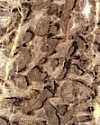 (source)
(source)
|
William Lonsdale
(9 Sep 1794 - 11 Nov 1871)
English geologist and paleontologist who became curator and librarian of the Geological Society of London (1829-42). His study of coral fossils, found in Devon, led to naming a new geologic system, the Devonian.
|
William Lonsdale
Excerpt from History of Geology (1910)
[p.90] Another geologist who rendered distinguished service, WILLIAM LONSDALE (1794-1871), was born in Bath, became an ensign in the King's Own Regiment in 1810, served in the Peninsular War, and was present at the battle of Waterloo. He retired as Lieutenant, and, according to his own statement, he became a geologist through hearing the conversation of two ladies about a fossil in the library at the Literary Institution at Bath. He determined to investigate the neighbourhood; and it is recorded by Sir A. Geikie that in 1825 Murchison accidentally met [p.91] him in a quarry, “a tall, grave man, with a huge hammer on his shoulder,” who proved to be so full of information that Murchison spent some days in Bath under his guidance. This introduction, no doubt, led to the appointment, in 1829, of Lonsdale as Curator and Librarian of the Geological Society of London at Somerset House, where he remained until 1842. In 1829 he read before the Society a paper on the Oolitic district near Bath, illustrated by sheets of the Ordnance one-inch map, which had been previously exhibited at the anniversary meeting in 1828. Then Fitton had remarked that “the maps thus coloured are probably as complete specimens of geological illustration as ever have been produced.” The paper itself was a model of careful and accurate observation. Lonsdale subsequently extended his researches among the oolites northwards to the Cotteswold Hills, and showed that the stone-tiles of “Slates” of Sevenhampton, in Gloucestershire, were equivalent to the Stonefield Slate at the base of the Great Oolite, and were not on the horizon of the Forest Marble, as had been supposed.
The age of the Stonesfield Slate, near Oxford, which had been worked since the time of Roman occupation for its stone-tiles, had become a matter of considerable interest a few years previously, on account of the reported discovery in it of mammalian remains...
[p.141] In 1836 Sedgwick and Murchison commenced a detailed examination of the older strata of Devonshire, with the view, at first, of determining the age of the Culm-measures which had been included in the Greywacke group. Their field-observations enabled them to decide that the Culm-bearing strata were of Carboniferous age, and included representatives of the true Coal-measures. The subject, however, grew in interest, and they devoted attention during the three following years to the elucidation of the age and succession of the older strata. Aided by the local knowledge and collections of fossils made by Godwin-Austen and by S. R. Pattison, they determined the broad general sequence of the rocks. Sedgwick, indeed, in 1820 had noted that the fossils of the Plymouth limestone were distinct from those of the Mountain limestone; and William Lonsdale, in December, 1837, expressed his opinion, from an examination of the South Devon fossils collected by [p.142] Godwin-Austen, that they belonged in a period between the Carboniferous and Silurian systems, and were, consequently, of the age of the Old Red Sandstone. This view was communicated to Sedgwick and Murchison, who in 1839 proposed that the name DEVONIAN be given to the great system of strata below the Carboniferous in the south-west of England. Thus the Cornish killas (in great part), the Plymouth and Torquay limestones, and other strata of slate and grit came to be grouped as Devonian. Fish-remains of Old Red Sandstone type (Cephalaspis, Pteraspis, etc.) were subsequently found by C. W. Peach, Pengelly and others, in the older Devonian rocks near Looe and Fowey.
Nevertheless, while the system, as a whole, was well-founded, the precise palaeontological relations of the Devonian and carboniferous were not established, and no definite base to the Devonian was discovered. Subsequent research has shown how much more complex is the structure in Cornwall and South Devon, and even in North Devon and West Somerset, than was at first supposed.
The establishment of the Devonian system in England stimulated research on the equivalent strata on the Continent, and especially on the borders of France, Belgium, and Germany, in the Ardennes, and country eastward to the Eifel and Coblenz. To the geologists in those [p.143] areas we are mainly indebted for the determination of the sequence of the subdivisions and their fossils...
- 9 Sep - short biography, births, deaths and events on date of Lonsdale's birth.




